Xiaojun Meng
and Other Contributors
Pangu Pro MoE: Mixture of Grouped Experts for Efficient Sparsity
May 28, 2025Abstract:The surgence of Mixture of Experts (MoE) in Large Language Models promises a small price of execution cost for a much larger model parameter count and learning capacity, because only a small fraction of parameters are activated for each input token. However, it is commonly observed that some experts are activated far more often than others, leading to system inefficiency when running the experts on different devices in parallel. Therefore, we introduce Mixture of Grouped Experts (MoGE), which groups the experts during selection and balances the expert workload better than MoE in nature. It constrains tokens to activate an equal number of experts within each predefined expert group. When a model execution is distributed on multiple devices, this architectural design ensures a balanced computational load across devices, significantly enhancing throughput, particularly for the inference phase. Further, we build Pangu Pro MoE on Ascend NPUs, a sparse model based on MoGE with 72 billion total parameters, 16 billion of which are activated for each token. The configuration of Pangu Pro MoE is optimized for Ascend 300I Duo and 800I A2 through extensive system simulation studies. Our experiments indicate that MoGE indeed leads to better expert load balancing and more efficient execution for both model training and inference on Ascend NPUs. The inference performance of Pangu Pro MoE achieves 1148 tokens/s per card and can be further improved to 1528 tokens/s per card by speculative acceleration, outperforming comparable 32B and 72B Dense models. Furthermore, we achieve an excellent cost-to-performance ratio for model inference on Ascend 300I Duo. Our studies show that Ascend NPUs are capable of training Pangu Pro MoE with massive parallelization to make it a leading model within the sub-100B total parameter class, outperforming prominent open-source models like GLM-Z1-32B and Qwen3-32B.
Pangu Light: Weight Re-Initialization for Pruning and Accelerating LLMs
May 26, 2025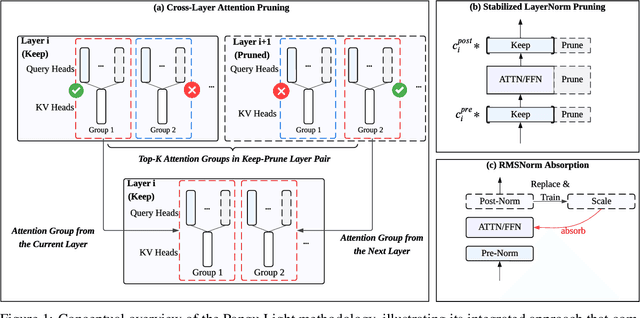

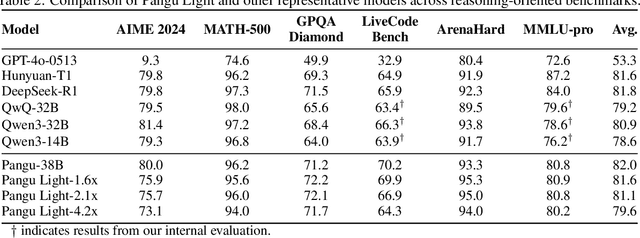
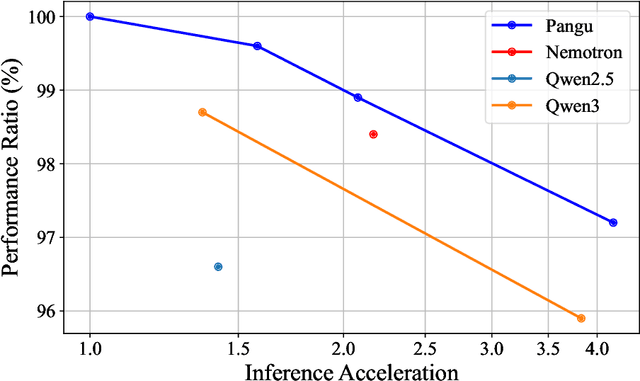
Abstract:Large Language Models (LLMs) deliver state-of-the-art capabilities across numerous tasks, but their immense size and inference costs pose significant computational challenges for practical deployment. While structured pruning offers a promising avenue for model compression, existing methods often struggle with the detrimental effects of aggressive, simultaneous width and depth reductions, leading to substantial performance degradation. This paper argues that a critical, often overlooked, aspect in making such aggressive joint pruning viable is the strategic re-initialization and adjustment of remaining weights to improve the model post-pruning training accuracies. We introduce Pangu Light, a framework for LLM acceleration centered around structured pruning coupled with novel weight re-initialization techniques designed to address this ``missing piece''. Our framework systematically targets multiple axes, including model width, depth, attention heads, and RMSNorm, with its effectiveness rooted in novel re-initialization methods like Cross-Layer Attention Pruning (CLAP) and Stabilized LayerNorm Pruning (SLNP) that mitigate performance drops by providing the network a better training starting point. Further enhancing efficiency, Pangu Light incorporates specialized optimizations such as absorbing Post-RMSNorm computations and tailors its strategies to Ascend NPU characteristics. The Pangu Light models consistently exhibit a superior accuracy-efficiency trade-off, outperforming prominent baseline pruning methods like Nemotron and established LLMs like Qwen3 series. For instance, on Ascend NPUs, Pangu Light-32B's 81.6 average score and 2585 tokens/s throughput exceed Qwen3-32B's 80.9 average score and 2225 tokens/s.
Dynamic Sampling that Adapts: Iterative DPO for Self-Aware Mathematical Reasoning
May 22, 2025Abstract:In the realm of data selection for reasoning tasks, existing approaches predominantly rely on externally predefined static metrics such as difficulty and diversity, which are often designed for supervised fine-tuning (SFT) and lack adaptability to continuous training processes. A critical limitation of these methods is their inability to dynamically align with the evolving capabilities of models during online training, a gap that becomes increasingly pronounced with the rise of dynamic training paradigms and online reinforcement learning (RL) frameworks (e.g., R1 models). To address this, we introduce SAI-DPO, an algorithm that dynamically selects training data by continuously assessing a model's stage-specific reasoning abilities across different training phases. By integrating real-time model performance feedback, SAI-DPO adaptively adapts data selection to the evolving strengths and weaknesses of the model, thus enhancing both data utilization efficiency and final task performance. Extensive experiments on three state-of-the-art models and eight mathematical reasoning benchmarks, including challenging competition-level datasets (e.g., AIME24 and AMC23), demonstrate that SAI-DPO achieves an average performance boost of up to 21.3 percentage points, with particularly notable improvements of 10 and 15 points on AIME24 and AMC23, respectively. These results highlight the superiority of dynamic, model-adaptive data selection over static, externally defined strategies in advancing reasoning.
Pangu Ultra MoE: How to Train Your Big MoE on Ascend NPUs
May 07, 2025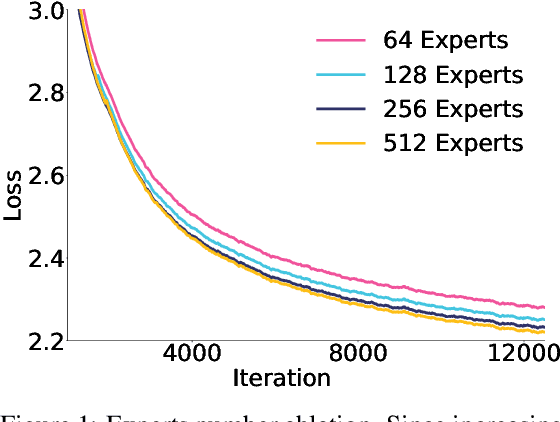

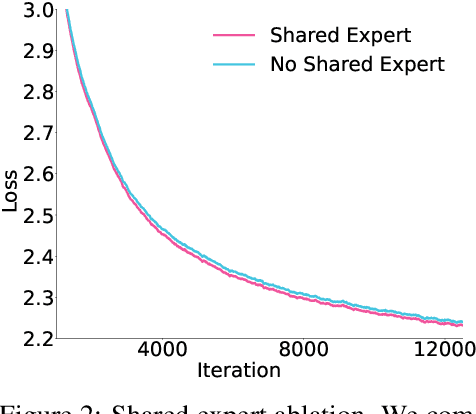

Abstract:Sparse large language models (LLMs) with Mixture of Experts (MoE) and close to a trillion parameters are dominating the realm of most capable language models. However, the massive model scale poses significant challenges for the underlying software and hardware systems. In this paper, we aim to uncover a recipe to harness such scale on Ascend NPUs. The key goals are better usage of the computing resources under the dynamic sparse model structures and materializing the expected performance gain on the actual hardware. To select model configurations suitable for Ascend NPUs without repeatedly running the expensive experiments, we leverage simulation to compare the trade-off of various model hyperparameters. This study led to Pangu Ultra MoE, a sparse LLM with 718 billion parameters, and we conducted experiments on the model to verify the simulation results. On the system side, we dig into Expert Parallelism to optimize the communication between NPU devices to reduce the synchronization overhead. We also optimize the memory efficiency within the devices to further reduce the parameter and activation management overhead. In the end, we achieve an MFU of 30.0% when training Pangu Ultra MoE, with performance comparable to that of DeepSeek R1, on 6K Ascend NPUs, and demonstrate that the Ascend system is capable of harnessing all the training stages of the state-of-the-art language models. Extensive experiments indicate that our recipe can lead to efficient training of large-scale sparse language models with MoE. We also study the behaviors of such models for future reference.
Pangu Ultra: Pushing the Limits of Dense Large Language Models on Ascend NPUs
Apr 10, 2025Abstract:We present Pangu Ultra, a Large Language Model (LLM) with 135 billion parameters and dense Transformer modules trained on Ascend Neural Processing Units (NPUs). Although the field of LLM has been witnessing unprecedented advances in pushing the scale and capability of LLM in recent years, training such a large-scale model still involves significant optimization and system challenges. To stabilize the training process, we propose depth-scaled sandwich normalization, which effectively eliminates loss spikes during the training process of deep models. We pre-train our model on 13.2 trillion diverse and high-quality tokens and further enhance its reasoning capabilities during post-training. To perform such large-scale training efficiently, we utilize 8,192 Ascend NPUs with a series of system optimizations. Evaluations on multiple diverse benchmarks indicate that Pangu Ultra significantly advances the state-of-the-art capabilities of dense LLMs such as Llama 405B and Mistral Large 2, and even achieves competitive results with DeepSeek-R1, whose sparse model structure contains much more parameters. Our exploration demonstrates that Ascend NPUs are capable of efficiently and effectively training dense models with more than 100 billion parameters. Our model and system will be available for our commercial customers.
Friends-MMC: A Dataset for Multi-modal Multi-party Conversation Understanding
Dec 23, 2024Abstract:Multi-modal multi-party conversation (MMC) is a less studied yet important topic of research due to that it well fits real-world scenarios and thus potentially has more widely-used applications. Compared with the traditional multi-modal conversations, MMC requires stronger character-centered understanding abilities as there are many interlocutors appearing in both the visual and textual context. To facilitate the study of this problem, we present Friends-MMC in this paper, an MMC dataset that contains 24,000+ unique utterances paired with video context. To explore the character-centered understanding of the dialogue, we also annotate the speaker of each utterance, the names and bounding bboxes of faces that appear in the video. Based on this Friends-MMC dataset, we further study two fundamental MMC tasks: conversation speaker identification and conversation response prediction, both of which have the multi-party nature with the video or image as visual context. For conversation speaker identification, we demonstrate the inefficiencies of existing methods such as pre-trained models, and propose a simple yet effective baseline method that leverages an optimization solver to utilize the context of two modalities to achieve better performance. For conversation response prediction, we fine-tune generative dialogue models on Friend-MMC, and analyze the benefits of speaker information. The code and dataset is publicly available at https://github.com/yellow-binary-tree/Friends-MMC and thus we call for more attention on modeling speaker information when understanding conversations.
VideoLLM Knows When to Speak: Enhancing Time-Sensitive Video Comprehension with Video-Text Duet Interaction Format
Nov 27, 2024



Abstract:Recent researches on video large language models (VideoLLM) predominantly focus on model architectures and training datasets, leaving the interaction format between the user and the model under-explored. In existing works, users often interact with VideoLLMs by using the entire video and a query as input, after which the model generates a response. This interaction format constrains the application of VideoLLMs in scenarios such as live-streaming comprehension where videos do not end and responses are required in a real-time manner, and also results in unsatisfactory performance on time-sensitive tasks that requires localizing video segments. In this paper, we focus on a video-text duet interaction format. This interaction format is characterized by the continuous playback of the video, and both the user and the model can insert their text messages at any position during the video playback. When a text message ends, the video continues to play, akin to the alternative of two performers in a duet. We construct MMDuetIT, a video-text training dataset designed to adapt VideoLLMs to video-text duet interaction format. We also introduce the Multi-Answer Grounded Video Question Answering (MAGQA) task to benchmark the real-time response ability of VideoLLMs. Trained on MMDuetIT, MMDuet demonstrates that adopting the video-text duet interaction format enables the model to achieve significant improvements in various time-sensitive tasks (76% CIDEr on YouCook2 dense video captioning, 90\% mAP on QVHighlights highlight detection and 25% R@0.5 on Charades-STA temporal video grounding) with minimal training efforts, and also enable VideoLLMs to reply in a real-time manner as the video plays. Code, data and demo are available at: https://github.com/yellow-binary-tree/MMDuet.
Learning to Compress Contexts for Efficient Knowledge-based Visual Question Answering
Sep 11, 2024Abstract:Multimodal Large Language Models (MLLMs) have demonstrated great zero-shot performance on visual question answering (VQA). However, when it comes to knowledge-based VQA (KB-VQA), MLLMs may lack human commonsense or specialized domain knowledge to answer such questions and require obtaining necessary information from external knowledge sources. Previous works like Retrival-Augmented VQA-v2 (RAVQA-v2) focus on utilizing as much input information, such as image-based textual descriptions and retrieved knowledge, as possible to improve performance, but they all overlook the issue that with the number of input tokens increasing, inference efficiency significantly decreases, which contradicts the demands of practical applications. To address this issue, we propose Retrieval-Augmented MLLM with Compressed Contexts (RACC). RACC learns to compress and aggregate retrieved contexts, from which it generates a compact modulation in the form of Key-Value (KV) cache. This modulation is then used to adapt the downstream frozen MLLM, thereby achieving effective and efficient inference. RACC achieves a state-of-the-art (SOTA) performance of 62.9% on OK-VQA. Moreover, it significantly reduces inference latency by 22.0%-59.7% compared to the prominent RAVQA-v2. Abundant experiments show RACC's broad applicability. It is compatible with various off-the-shelf MLLMs and can also handle different knowledge sources including textual and multimodal documents.
End-to-End Video Question Answering with Frame Scoring Mechanisms and Adaptive Sampling
Jul 23, 2024



Abstract:Video Question Answering (VideoQA) has emerged as a challenging frontier in the field of multimedia processing, requiring intricate interactions between visual and textual modalities. Simply uniformly sampling frames or indiscriminately aggregating frame-level visual features often falls short in capturing the nuanced and relevant contexts of videos to well perform VideoQA. To mitigate these issues, we propose VidF4, a novel VideoQA framework equipped with tailored frame selection strategy for effective and efficient VideoQA. We propose three frame-scoring mechanisms that consider both question relevance and inter-frame similarity to evaluate the importance of each frame for a given question on the video. Furthermore, we design a differentiable adaptive frame sampling mechanism to facilitate end-to-end training for the frame selector and answer generator. The experimental results across three widely adopted benchmarks demonstrate that our model consistently outperforms existing VideoQA methods, establishing a new SOTA across NExT-QA (+0.3%), STAR (+0.9%), and TVQA (+1.0%). Furthermore, through both quantitative and qualitative analyses, we validate the effectiveness of each design choice.
HawkEye: Training Video-Text LLMs for Grounding Text in Videos
Mar 15, 2024



Abstract:Video-text Large Language Models (video-text LLMs) have shown remarkable performance in answering questions and holding conversations on simple videos. However, they perform almost the same as random on grounding text queries in long and complicated videos, having little ability to understand and reason about temporal information, which is the most fundamental difference between videos and images. In this paper, we propose HawkEye, one of the first video-text LLMs that can perform temporal video grounding in a fully text-to-text manner. To collect training data that is applicable for temporal video grounding, we construct InternVid-G, a large-scale video-text corpus with segment-level captions and negative spans, with which we introduce two new time-aware training objectives to video-text LLMs. We also propose a coarse-grained method of representing segments in videos, which is more robust and easier for LLMs to learn and follow than other alternatives. Extensive experiments show that HawkEye is better at temporal video grounding and comparable on other video-text tasks with existing video-text LLMs, which verifies its superior video-text multi-modal understanding abilities.
 Add to Chrome
Add to Chrome Add to Firefox
Add to Firefox Add to Edge
Add to Edge